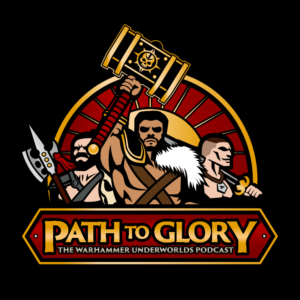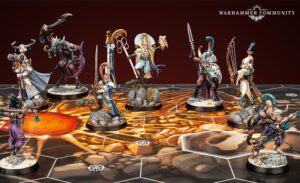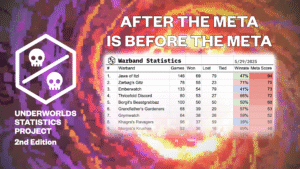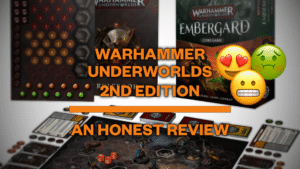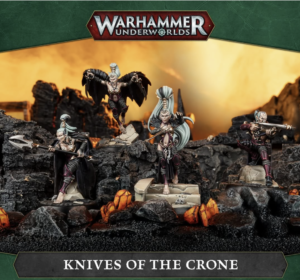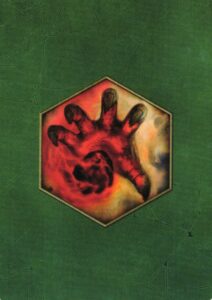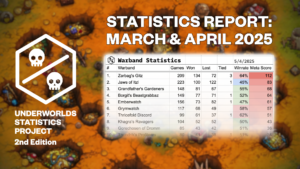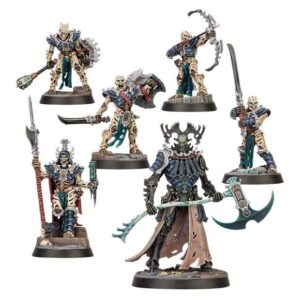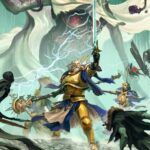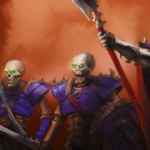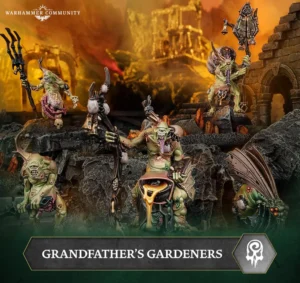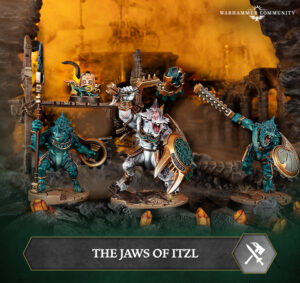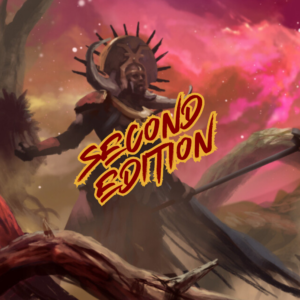Well met, and welcome to the next installment in the ‘State of the Hexes’ series! For those of you unfamiliar, the idea of these articles are to highlight the current state of the Warhammer Underworlds meta. I use data to supplement my understanding of the current state of the game but at the end of the day, this is an opinion based article.
If you are interested in reading the last article, check out this link. It’s currently on my old website, ‘Hexes & Warbands’ but it will eventually port over to here. We’ve procrastinated a bit but hey, it’s a new year. We’ll pick it up. 😉
In this article I will summarize the current meta, share the top 5 decks, look at the top 5 universal objectives, gambits, and upgrades, take a stab at creating a tier list, as well as share my closing thoughts. I’ll be referencing the results of the most recent online clash hosted over in the Discord community to reinforce why certain warband strategies are more dominant than others. Shoutout to ‘Shoobie’ for running the community and TO’ing the event!
____________________
Current Meta State: Post Direchasm Game Set
TL;DR: Direchasm is in full swing! Mollog is rampaging through the competitive scene and pulverizing opponents. Primacy has been a huge help here, though many warbands have benefitted from it. The freshmen on the block, Myari’s Purifiers and The Dread Pageant, have been very popular and have found ways to creatively pump out glory to match with the best of them. Objective based strategies are still present, and dare I say thriving. Holding 2 objectives has proven to be more efficient than 3 and The Grymwatch, Lady Harrow’s Mournflight, and even the Thorns of the Briar Queen are racking up the glory tokens. Morgok’s Krushas are loving Primacy and because they are so hard to take down, they are demanding an answer via damage upgrades and mitigation. Thundrik’s Profiteers have made a pseudo comeback by relying on their counter charge efficiency and a solid hold objective strategy. Truly, the meta is diverse and factions like Hrothgorn’s Mantrappers, Magore’s Fiends, Zarbag’s Gitz, and the Wurmspat are holding their own – even thriving. As a fact of reality, there are some warbands that just do things at greater levels of efficiency which might lead them to be more prevalent. Still, the meta’s in a great place – there’s just a little bit of tweaking required by an inevitable future FaR.
With the rotation of Nightvault, and the introduction of the Direchasm season, we’ve seem some massive shifts in the meta. Our objective based overlords have now taken a backseat as we celebrate the resurgence of aggressive strategies. Now the meta is not an all out aggro-fest but there is significantly more engagement on the board and end phase scoring has become quite tactical. There is a lot of choice, meaningful ones, throughout the game and the plethora of viable warbands is at a level we haven’t seen in months, if not years.In a way, we’re playing a more complicated (in a good way) version of Shadespire and Nightvault. The one-shot meta is back and VOLTRON (stacking multiple upgrades on a single fighter) strategies have seen a resurgence. Namely, the Mortis Relics are huge here. The compounding benefits and the ability to manipulate the boards, as well as draw additional resources, are extremely powerful.
The biggest benefactor of these strategies has been Mollog’s Mob. We all know how destructive the mighty troll can be but with the new upgrades and gambits introduced, he’s been a literal wrecking ball. Damaging him is the easy part. Damaging again after his heal, due to Ferocious Resistance, is the challenge. The post-inspiration stats on his squig peons can lead them to be sticky as well, much to the chagrin of charging opponents. It is now paramount that players plan around warbands with high health fighters and that is primarily due to Mollog, and to a lesser extent Morgok’s Krushas. Primacy has been a nice, although somewhat inconsistent, source of glory for them too.
The two warbands introduced in the Direchasm game set, Myari’s Purifiers and The Dread Pageant, have become sleeper hits. The community was intrigued by their flex-style ability and not knowing what kind of strategy you’ll face when matching up against them has proven to be quite the strength. Having 4 members a piece allows them to play either aggressive or hold objectives, usually both. Both warbands also have some hard hitters via Bahannar and Vasilac too respectively which can catch you off guard more often than you think. The faction objectives and power cards are also great and offer something for everyone.
The Grymwatch, backed by some awesome faction cards, are staying quite relevant, and doing quite well. Holding objectives are still a great plan and an even better source of glory generation. These guys love Dominant Position and have the tools to score it. It pairs well with Uncontested. too. As we know, they have some awesome post-inspiration stats which allows them to fight against the increasing levels of aggression and their ability to cycle through their surges, given a decent hand, it still second to none. While primacy can be a hindrance, Duke Crackmarrow and Gristlewel can sometimes rip the token away from the opponent in order for them to gain that spent glory point.
Lady Harrow’s are another objective based warband that has continued to stay in the upper echelons of the competitive scene. The warbands access to easy surges and movement enhancing upgrades allow players to cycle through their deck at astonishing rates. They also have that uncanny 2 dodge that feels like its impossible to hit at times. Their glory generation is also solid, especially with the addition of Dominant Position. Holding two objectives, as we’ve seen previously, pays dividends.
Thorns of the Briar Queen did get hard in the last FaR list but in a way it’s actually made deck building simpler for them. Now that Treacherous Foe is restricted, Thorns players are ditching the reactions and going all in on the hold objective strategy. As we all know, the Briar Queen, Varclav, and The Everhanged can be nuisances and often can elevate to being sticky ones at that. Varlcav’s push still makes them the most efficient move/push faction in the game and when the Surges come out right, they can rival the Grymwatch in terms of glory generation. Primacy is annoying for them but when the Briar Queen is hitting for 4+ damage and 4 fury, it can often work in their favor.
Morgok’s Krushas, while off to a slow start, are starting to gain their stride in the Direchasm meta. They’ve got great surge objectives, are super tanky, and hit like trucks. Accuracy and speed will always be issues but Spectral Wings, Malkyn Grace, and Savage Speed solve the latter issue quite well. As more accuracy trickles its way over the course of the season, these guys will be the one to keep an eye out for.
Thundrik’s Profiteers are also doing well. Though they struggled during the tail-end of Beastgrave, they did pretty alright when they focused on holding objectives and counter attacking. Re-focusing their efforts on those all important objective tokens has dramatically helped their efficiency. Though they are slow, Drakskewer kind of offsets this with his movement of 4. A cheeky Cover Ground or an unexpected Winged Death comes up more often than you think. Furthermore, there are a plethora of supplementing gambit cards, including Seek the Skyvessel, which can allow them to out-push their opponent. They are sacrificing ping damage and accuracy but 2 smash is decently reliable. Their range is also a big deal – being able to fire away, if they survive the charge, is amazing.
The rest of the meta generally consists of Hrothgorn’s Mantrappers, Rippa’s Snarlfangs, and a bunch of others. The challenge, as always, is that sometimes these warbands don’t feel like they have the tools to compete. As always, these warbands have game but need an experience pilot and/or some luck to power through the upper ceilings of the meta. Great players can always do even greater things with the warbands of their choice given they put in the practice.
Top 5 Decks:
1. Mollog’s Mob – Aggro/Control Build
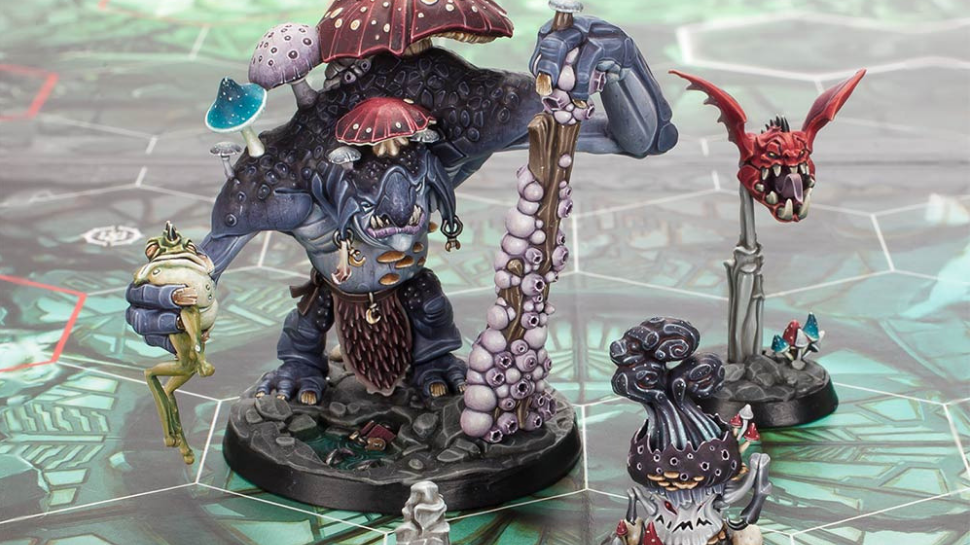
While this deck didn’t win the recent aforementioned event, it is a masterpiece of filth and canny tactics. While it takes some creativity to inspire Mollog, he generally ends up inspiring the traditional way – tanking damage. The deck takes advantage of that fact as well as Mollog’s high damage output and survivability. Once the upgrades start stacking, it takes a massive commitment to take him down. He becomes a staggering control piece as well as he has plenty of glory to spend while manipulating his opponents via the Mortis Relics. Unlike previous popular Hrothgorn builds, you need Mollog to do all of the heavy lifting which makes the opposing game plan pretty straightforward. The beauty of the deck is in its simplicity – stack upgrades and smash.
If you’re interested in trying this strategy out, check out Michael Carlin’s (Steel City Underworlds) deck. He’s quite literally the authority on Mollog and has devised many ways to keep the troll relevant over the past couple of seasons. He got 3rd last weekend. You can also check out this deck which placed 2nd this last weekend as well. It functions similarly but there are differences in the gambits and objectives.
2. Lady Harrow’s Mournflight – Hold Objective/Flex Build
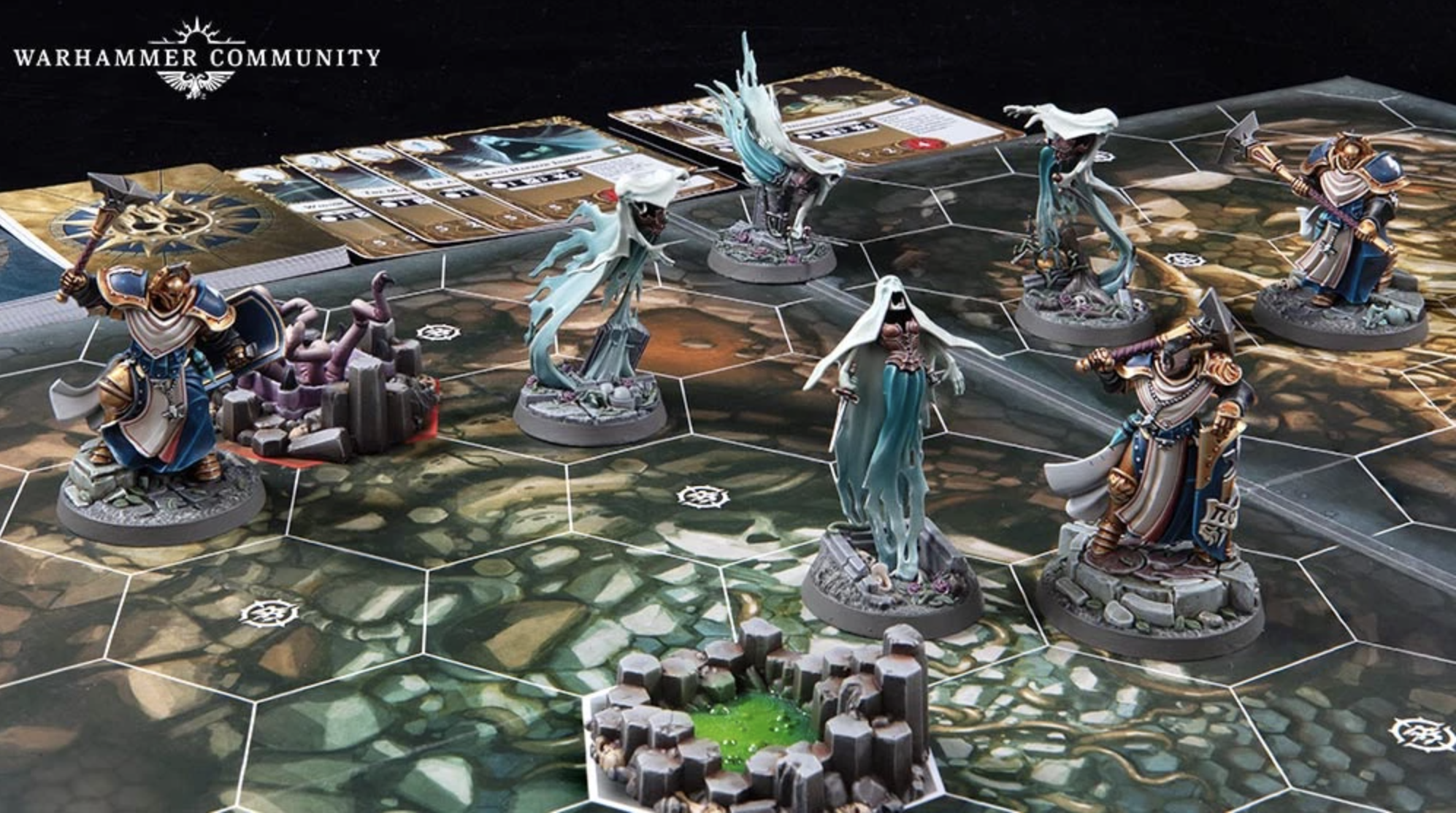
We mentioned earlier that Lady Harrow’s Mournflight is great at flying around the board as it pairs well with their easy Surges, universal or faction. As I mentioned in my previous article in this series, this warband is never far from the upper echelons of the meta. Unique fighter abilities, including the Screaming Maiden ability to murder opponents and Lady Harrow‘s ability to skip across the board (people forget about that one a lot), allow these harrowing ladies to keep up and brawl with the best of them. Most decks stack up on movement, score a bunch of trivial, passive Surges, and only commit fighters when they have to. If a player happens to “draws the nuts”, it’s very hard to keep up. Veteran players will know how to combat them and as such by denying cards like Ghostly Torment but still, it’s harder than it sounds.
Check out Erik’s deck – he placed top 4 in the event this past weekend. It’s the deck to take for a whirl if you want to try these femme fatales.
3. The Grymwatch – Hold Objective Build
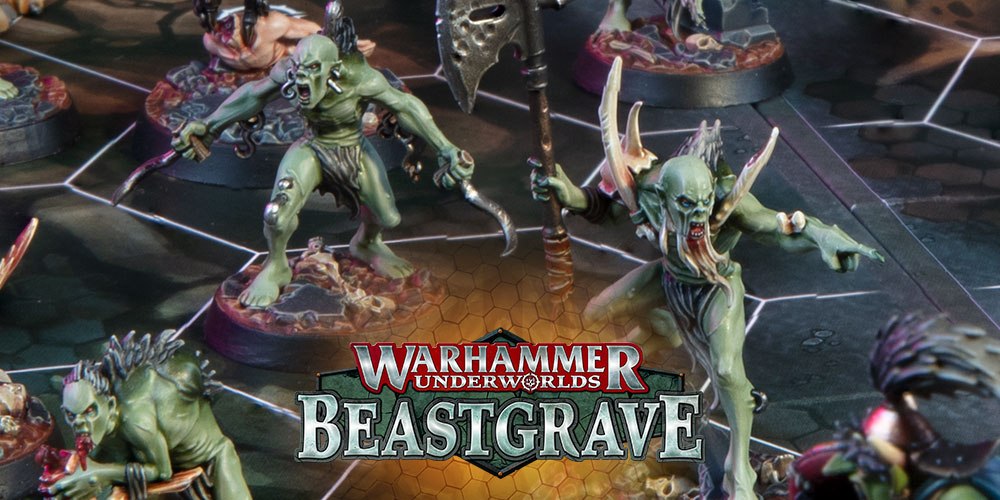
For the uninitiated, The Grymwatch are great at holding objectives and counter charging. They’ve got the bodies, the movement, and most importantly, the objectives. As mentioned earlier, these ghouls love holding objectives (usually 2) while manipulating the board state to their terms. Consistently scoring off the same game state is extremely rewarding as long as they win the “push game.” Once the glory starts coming in, the Duke becomes a monster. Don’t sleep on Duke’s Harriers either – give them Great Strength and a scything 3 fury, 2 damage attack can mince through opposing fighters. As always, the inspire can be tricky but the the flesh eaters usually have the tools to fend off invading opponents.
While most of you are familiar with the general style of the deck, I’ve found this one to be quite consistent. It got 5th place in the event this past weekend, narrowly missing the top 4.
4. Myari’s Purifiers – Aggro/Flex Build
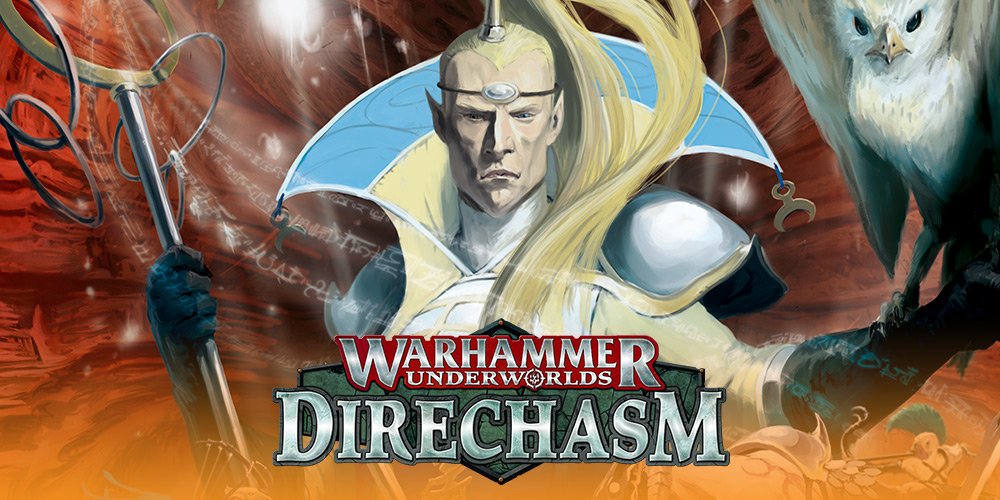
Myari’s Purifiers are interesting warband and I’m still not sold on their inclusion in this list. However, you can’t argue with the data – they won the event last weekend and were fairly represented. Whether that was because of people wanting to play the shiny new warband off the block or they really are that good is yet to be determined. Regardless, they are popular and doing well. As mentioned earlier their strengths lie in the fact that they are quite versatile. You never really know what kind of deck you are facing. The most common variant is a hybrid build that focuses on scoring glory through multiple avenues. The hold objective version is pretty decent as well with the aggro build being slightly suboptimal. A big factor for their success comes down to their strong defense rolls once inspired. Two block/dodge can be quite difficult to get through consistently and the propensity for defensive crits can be frustrating for an opponent. They’re able to tap into Primacy as well should they choose.
If you’re interested in giving these haughty Lumineth a go, check out the winning deck from last weekends online event. It was piloted by Daniel Skypala, a young talent who dominates his local scene in Czech Republic. If you are interested in a more hold objective strategy, check out this 8th place deck from the same event.
5. Morgok’s Krushas – Control/Objective Build
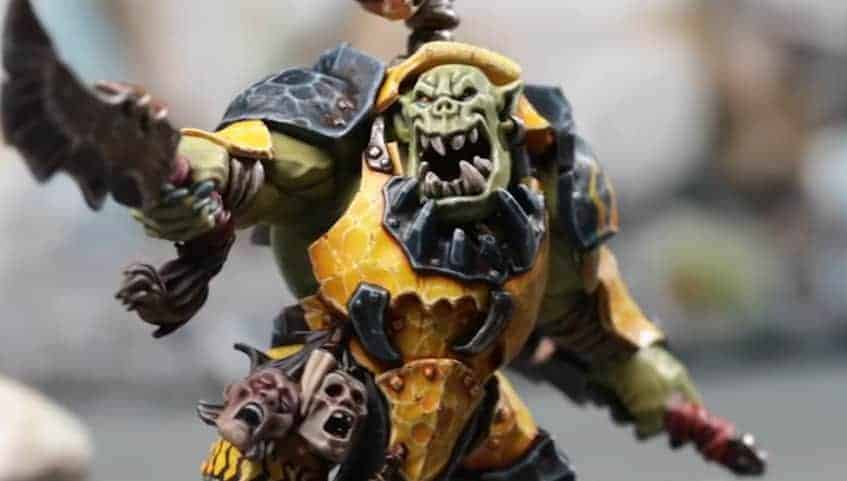
While this warband’s performance was underwhelming this past weekend, they are extremely popular in the meta and as such edge out the bottom of this list. Like Mollog, you have to be prepared to get through their high wound count. Unlike Mollog, they do have some great Surges that can stack fairly well which allows them to “power up” via that passive glory. Once the speed upgrades come out, these guys can bulldoze through your front line.
If you want to get your Waaagh! on, try this deck that placed 12th at last weekend’s event. Niccolo’s deck is also one to check out, he’s been doing fairly well with it in our practice group.
____________________
Top 5 Objectives:
The information below is supplemented by the latest online community clash which can be seen on UnderworldsDB. Ultimately, I might rank these cards differently in terms of popularity as this designed to be a general meta update.

Coming in at number 1, we’ve got Show of Force and it is great for all strategies and has the potential to be scored at almost any point in the game. Generally it is scored via the latter condition but many aggro, and even hybrid decks, can score this form the first condition often. It really just feels like free glory sometimes.
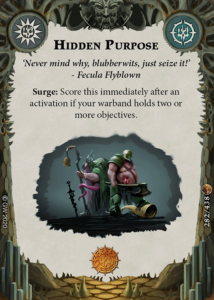
Next we’ve got Hidden Purpose. This card is just insane as virtually any warband, except for Mollog, can score it trivially. Whether you are playing aggressively or passively, you’ll be hard pressed to not include it in your deck.
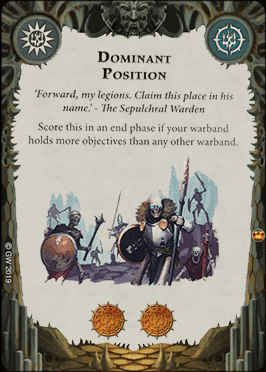
It is both good and scary to see an end phase objective being so popular. However, if you’ve played with, or against this card, you probably aren’t surprised. Since Beastgrave launched objectives have been very important on the board and this is still the case. Being able to gain two glory for simply holding one objective (or more) is very nice. Nowadays, everyone is packing push tech so out pushing your opponent is key. You’ll probably see this card in every warband aside from Mollog.
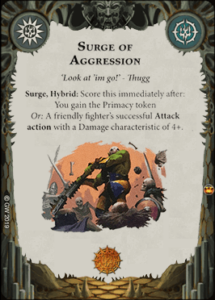
Primacy has been a big hit in the current meta and being able to score glory for simply obtaining it is pretty nice. What makes this card popular though is how easy it is to get to the 4 damage given the plethora of strength inducing upgrades. Honestly, people are scoring it more via the latter condition than the first.
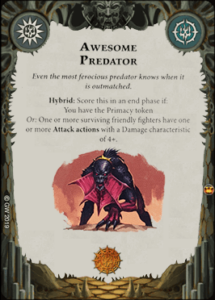
See above for why this card is good. It’s just the end phase version of its brother, Surge of Aggression. If you are taking one of these two, you are probably taking both. Essentially it is 2 glory for fulfilling the same criteria. Good stuff.
____________________
Top 5 Gambits:
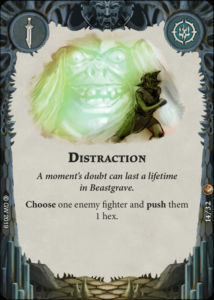
It’s a bit of a no-brainer here, this card is just really strong. It is arguably the strongest gambit ever to be printed and for good reason. This card will help you move enemy fighters in to charge range, push them off objectives, and perhaps even send them to their doom via lethals. Great versatility.
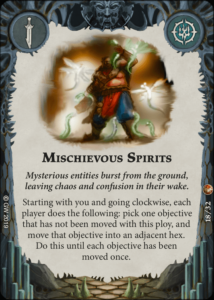
A lot of us have PTSD from the objective dominant play we saw rise to new heights in the Beastgrave meta. While Direchasm has toned that down a bit, we still see objectives being just as important in some cases. Being able to thwart your opponent’s end phase glory is huge. I daresay this card is keeping objective strategies in check. Still, it can be used to help get objective counters back in control as well. Often times it comes down to who can pay this card first.
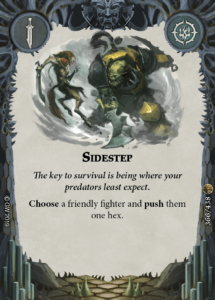
The polar opposite of Distraction, Sidestep allows you to do similar things. Whether it is bringing a fighter closer to charge range, pushing a friendly fighter out of an opponent’s threat range, or simply scooting on to an objective – this card is clutch.
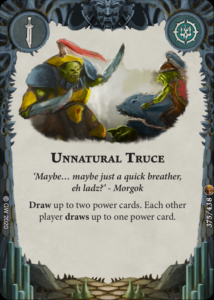
Unnatural Truce provides players with quicker access to their other cards in their power deck. It’s great for all the reasons above, despite the apparent drawback. Having a card advantage (more cards than your opponent) gives you more options and more consistency when trying to execute your game plan. While the card advantage isn’t as good when compared to Frenzied Search and Quick Search it is still helping you cycle through the deck so you can find your power cards in order to score your late game objectives like The Avatar Risen and To the End.
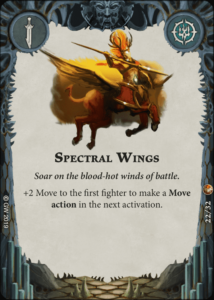
We couldn’t have this list without Spectral Wings. This card is great in a meta where the average move speed is 4. Not only does this help your aggressive engagement, it can also help you reach objectives previously out of reach. If you are running the objective “speed package”, then this is a must. Not only is it a source of solid glory, it is passive too.
____________________
Top 5 Upgrades:
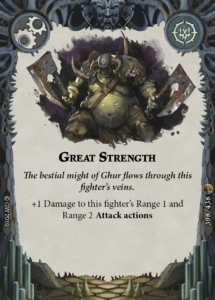
First up, we’ve got a three way tie between Great Strength, Sting of the Ur-Grub, and Savage Strength. Damage is a staple in this game. Being able solidify an elimination when you hit is a boon and as such, you’ll see these cards everywhere. Often people take all 3!
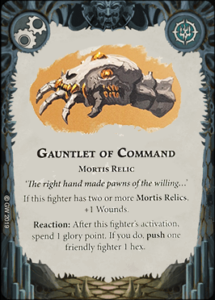
The most popular Mortis Relic and for good reason – it is un-restricted so there is no penalty to pay. Also, this is one of the few sources of wound upgrades in the game right now, so people are often taking two Mortis Relics to help their fighters stay longer on the board. The reaction is also very powerful. Being able to essentially get a free Sidestep, effectively, at the end of every action the equipped fighter makes is bonkers. Go on guard? Push a friendly fighter. Make a move? Push a friendly fighter. You get the idea.

Another Mortis Relic! Getting a 4th source of damage in your deck (or a solid replacement for the other mentioned above) is very nice and good (again for all the reasons mentioned above). The reaction is arguable more powerful given the description for Distraction. I’ve seen people abuse this to no end, not only are you manipulating the enemy’s warband multiple times a phase, if they are playing objectives – this makes it extremely difficult for them to score their end phase stuff. You’ll see it less than the Gauntlet of Command because of it’s well deserved restricted status.

The final Mortis Relic indeed does make the list. Often decks will include this and Gauntlet of Command if they don’t want to pay a restricted tax for Gauntlet of Dominance. However, usually you will see all 3 in a deck. The re-roll is nice and can come in clutch but you’re usually taking this to allow the effects of the other two to come into play. Redundancy is important in WHU deck building – the rule of 3 certainly applies here. This is also helps players dig for other cards which is great and can help you score To the End quite reliably.
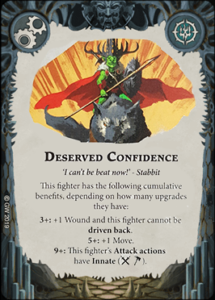
It was hard to pick between this card and Great Fortitude but honestly, they’re effectively the same as you really want that additional wound. Where this card differs is the equipped fighter cannot be driven back which is pretty nice if they’ve got a decent set of wounds and are adjacent to a lethal hex or on an objective. Where this card beats out Great Fortitude is the fact that you can gain compounding effects. While 3 is what you will see most of the time, getting 5 upgrades on a single fighter isn’t uncommon. After all, we are in a VOLTRON meta. The +1 move is nice but doesn’t really make me think twice about it. If you do manage to get 9 upgrades on a fighter (Mollog or Hrothgorn usually) then that fighter’s accuracy goes through the stratosphere. Innate’s are great feared for a good reason.
____________________
Warband Rankings:
In my last article, I mentioned that I struggle with ranked lists in Warhammer Underworlds. Now though, I think the game is in a place where the list is relevant and gives a decent snapshot of how things are going in the competitive state of the game. We’ve got 28 warbands in the game with Khagra’s Ravagers and the Starblood Stalkers right around the corner. I would like to state that all warbands are playable and can do well when built and piloted correctly. Any warband can do well provided a player put in the time and the practice.
Before we see the list, let’s define the tiers. If a warband means it is in the “S rank”, it is obvious quite powerful and have no real poor matchups. The “A rank” is defined as strong warbands who are doing well but can have bad matchups against other “S” and “A” rank warbands. The “B+ rank” groups warbands who are just on the cusp of doing as well as their “A rank” compatriots but have more glaring weaknesses and matchups. The “B rank” includes warbands that are playable but have got some tough matchups against the upper tiers. “C rank” warbands can be tricky to make work but unique enough to be worth experimenting with. Needless to say, they can have some brutal matchups. Lastly, the “D rank” warbands are in a tough spot. It can be really hard to make them work competitively and probably not worth the effort. More often there is another warband that just does what they do much better.

_____________________
Closing Thoughts:
As we can see, Mollog’s Mob reigns supreme as the strongest warband in the game right now. Not only can he decimate through opposing fighters, he’s also hard to kill. His build combines well with the Mortis Relics as well which allows him to dominate the control game.
Speaking of Mortis Relics, man are they good! They’ve permeated the meta to good effect and are a must have should a player want to be competitive in the current game. Personally, I find them to be a bit too strong and I wouldn’t be surprised if Gauntlet of Command is added to the FaR list in the future.
Looking at the rest of the meta, I think the balance is fairly spread. It is nice to see the warband variety. Magore’s Fiends and Spiteclaw’s Swarm are holding it down for Shadespire and we’ve seen a couple Nightvault warbands make a comeback. Beastgrave warbands are generally out performing the other warbands from previous seasons. Generally this is because of their above average faction cards. I’m not sold on the success of Myrari’s Purifiers. While I think both Direchasm warbands are good, I think their success stems from people wanting to play new warbands. The more people that play them, the more often you’ll see them perform well.
Overall, the current competitive scene feels good. While you can play anything you want, I’d recommend playing Mollog if you want to win. If you want to try something different but stay competitive, I recommend playing warbands in the B+ tier and up. All of them can hold their own and perform quite admirably given the practice and time. With that being said, I personally would stay away from the D tier.
In order to succeed, focus on executing your game plan while mitigating your opponent’s. If you are playing against Mollog, either take him down quickly (and hope he doesn’t have Ferocious Resistance) or ignore him and go for the squigs. His 2 smash is good but can miss often. Sometimes it is better to let him bumble about while doing your own thing – like holding objectives. If he can’t inspire, he can’t do too much! Worst case scenario, pray for Rebound to go off! 😛 Aside from that, make sure you’ve got the tools to fight against aggro and objective styles of play. If you can do that, you’ll be in a good spot.
As always, best of luck on YOUR Path to Glory.
Aman
